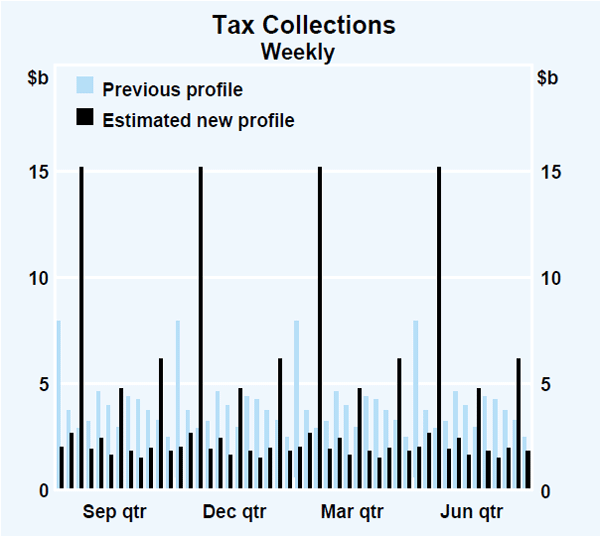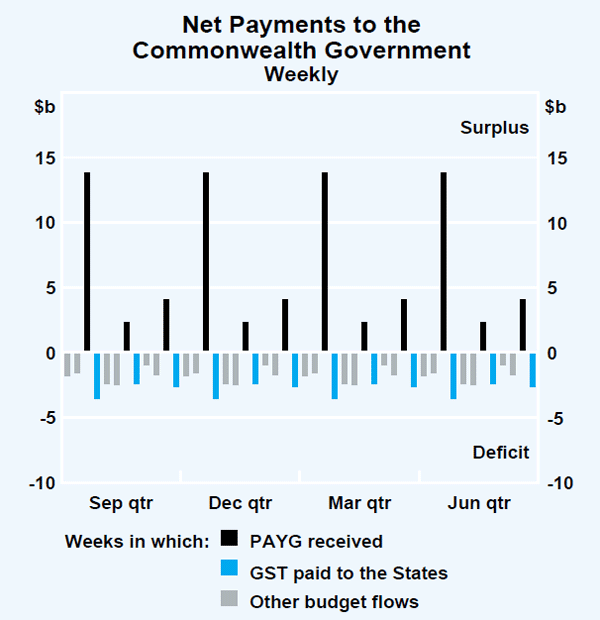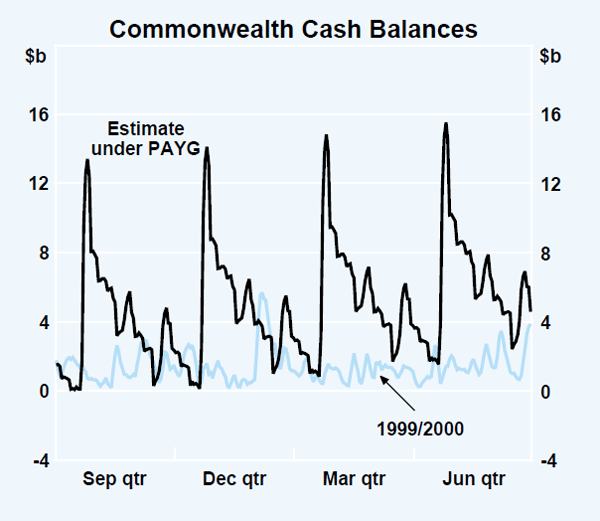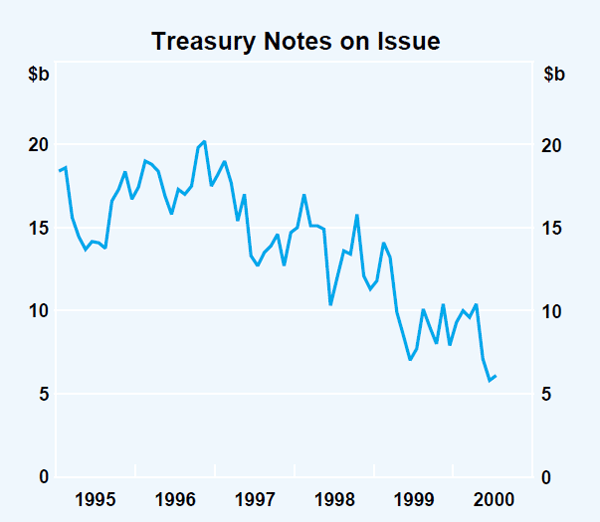Bulletin – August 2000 Implications for the Reserve Bank's Liquidity Management Operations of Changes in Commonwealth Government Cash Flows
- Download 88KB
Introduction
The Reserve Bank implements monetary policy by undertaking operations in the money market to maintain the cash rate – the interest rate at which financial institutions borrow and lend overnight funds – near its announced target level. These market operations achieve this objective by balancing the supply of settlement funds with banks' demand for them, at the target rate. An influence on the demand for settlement funds is payments made by the private sector to the Commonwealth Government. The new tax arrangements, in particular the Pay-As-You-Go (PAYG) arrangements, will significantly affect the timing of tax payments to the Commonwealth Government.[1] This note discusses how the changed arrangements will affect banking system liquidity and the liquidity management operations of the Reserve Bank.
Commonwealth Cash Management
In future, most businesses will remit tax payments on or before the 21st of the months of January, April, July and October each year, resulting in a more concentrated pattern of tax payments. While they remain subject to a degree of uncertainty, current estimates are that, once the new arrangements are fully operational, a total of around $15 billion will be collected in the few days around each of the main PAYG dates (Graph 1).[2] This peak is around double the previous quarterly peak in tax collections associated with company tax.

Around a third of the new tax collections will be GST-related and remitted to the States on the 27th of the month concerned, under agreed arrangements. This means that there will be a significant reversal of tax influences in the week following the PAYG date. Since the pattern of government outlays is generally quite steady, however, the new tax arrangements will have a marked impact on the Commonwealth's budget balance. The typical pattern each quarter will be a large surplus associated with the PAYG tax dates and deficits at other times. Graph 2 shows the overall pattern in Commonwealth flows on a weekly basis, taking into account payments as well as taxes. Obviously, flows to the Government are the mirror image of the liquidity flows from the private sector.

Absent any offsetting transactions, the more pronounced pattern of tax flows would show in the pattern of the Commonwealth's cash balances, which would be expected to rise sharply around the third week of each quarter, then gradually decline over the following three months (Graph 3). This pattern would be much more pronounced than the pattern of cash balances over recent financial years. Such a profile of cash balances would be both costly and inefficient since it would involve considerable volatility and an unacceptably high average level of balances. Managing lumpy tax payments is not a new issue. The more concentrated pattern of tax receipts, however, will require larger operations to smooth cash flows than have occurred at least in the recent past.

From the perspective of the Commonwealth's cash management, these cash flows could be smoothed by active management of its stock of short-term assets. The Commonwealth has built up a stock of investments over the past year as it has placed proceeds from Budget surpluses in term deposits at the Reserve Bank. These term deposits have, on occasion, assisted the management of the Commonwealth's cash balances, since they have matured at times when the Commonwealth might otherwise have needed to borrow from the market. There will be further scope under the new tax arrangements to tailor short-term investments to mature at convenient times for cash management. This approach, however, would not help the private sector prepare for the liquidity impact of the PAYG period, nor assist the Reserve Bank manage system liquidity.
An alternative approach involves managing cash balances primarily with the issue of Treasury notes. Treasury notes are short-term securities issued by the Commonwealth to bridge within-year mismatches between its receipts and outlays. They, historically, have been the principal instrument for smoothing cash balances, as they have been issued to fund temporary, or seasonal, deficits with notes due to mature in periods of temporary surpluses. The level of Treasury notes on issue has tended to decline in recent years as the Commonwealth has moved into large Budget surplus, a situation which has also tended to reduce the need to issue these securities for cash management purposes (Graph 4).

Treasury notes have traditionally been issued with standard maturities of 5, 13 and 26 weeks. The terms of Treasury notes have recently been modified to help handle the more pronounced pattern of Commonwealth receipts. Instead of being issued with a standard term, Treasury notes are now issued to a specific maturity date around the relevant PAYG dates in January, April, July and October. This will result in fewer lines of Treasury notes on issue, but these lines will be larger and more liquid.[3] As well as assisting the Commonwealth meet its cash management objectives, these Treasury notes will assist the private sector manage its liquidity since the liquidity drain that occurs at times when its tax obligations are heaviest will be partly offset by flows to the private sector from maturing Treasury notes.
If the Commonwealth took no action to smooth its cash flows, the resulting swings in banks' liquidity could, in principle, be offset by the Reserve Bank exclusively through its market operations – by withdrawing liquidity when the Commonwealth is in deficit and injecting liquidity when the tax payments are received. In practice, however, this would involve large swings in the Reserve Bank's own balance sheet.
In practice, the Commonwealth seems likely to smooth its cash balances through a combination of managing its term deposits as well as Treasury note issuance. Flows to the Commonwealth are, therefore, still likely to have a significant impact on private sector liquidity, which will need to be accommodated by the Reserve Bank's market operations.
Reserve Bank Market Operations
The first part of this section provides broad estimates of liquidity flows once the new arrangements are fully in place; the second part provides some figuring for the coming PAYG period.
The ‘typical’ PAYG cycle
In the absence of offsetting transactions, the new pattern of tax payments would result, in broad terms, in three phases of liquidity during each PAYG cycle:
- the period ahead of each main PAYG date – when the Commonwealth's expenditure generally exceeds its receipts, adding liquidity to the banking system;
- the period around PAYG dates themselves – when tax is received, withdrawing liquidity; and
- the date on which the Commonwealth remits GST receipts to the States, returning liquidity to the banking system.
The profile expected of a typical PAYG tax cycle, when the PAYG arrangements become fully operational and assuming full-year budget projections similar to those for 2000/01, is summarized in Table 1. (Purely for illustrative purposes, the typical tax cycle is assumed to be the January–April cycle.)
| 28 January – 19 April |
20 April – 26 April |
27 April | Total | |
|---|---|---|---|---|
| Gross government payments | +37 | +2 | +4 | +43 |
| Gross tax receipts | −29 | −15 | 0 | −44 |
| Net government transactions | +8 | −13 | +4 | −1 |
| Net new Treasury note issuance | −6 | +6 | 0 | 0 |
| Net cash market impact | +2 | −7 | +4 | −1 |
| Reserve Bank operations | −2 | +7 | −4 | +1 |
| Net impact on private sector liquidity | 0 | 0 | 0 | 0 |
| (a) The figures here are expressed in terms of their impact on the cash market. Negative signs indicate a reduction in private sector liquidity; plus signs indicate an injection of liquidity. All figures in Table 1 are on a ‘cash’ basis. They differ from the Budget treatment of the GST, for example, since the GST is netted from Budget revenues and outlays, as these receipts merely pass across the Commonwealth's Budget on their way, with a short lag, to the States. In terms of the Commonwealth's banking arrangements as captured in Table 1, however, GST receipts represent a ‘gross receipt’, while the remittance to the States represents a ‘gross payment’. | ||||
On these assumptions, once the PAYG arrangements become fully operational, the Commonwealth might be expected to run a cumulative deficit of about $8 billion in the first part of the quarterly tax cycle. While decisions about Treasury note issuance will be taken from week-to-week according to cash requirements, aggregate issuance during this phase might be around $6 billion. This would cover a large part of the Government's cash needs, the rest coming from a reduction in its term deposits. It would also offset the bulk of the liquidity impact on the market, leaving a net injection of $2 billion to be offset by the Reserve Bank's market operations, most likely by selling Commonwealth Government Securities (CGS) under repos, or undertaking foreign exchange swaps with the same effect.
In the tax collection period, shown here as 20–26 April, the Commonwealth will run a large cash surplus. The cash impact would be partly offset by Treasury note maturities.
In a typical tax cycle, around $15 billion in taxes are forecast to be paid around the main PAYG tax dates, with most of this tax due to be paid on or before the 21st of the month. Experience suggests that payments will be spread over a week or so, with a peak (of perhaps $8 billion) in remittances falling on the due date. Since taxpayers typically make payments by cheque, with interbank settlement via overnight settlement arrangements as opposed to real-time gross settlement, the major liquidity impact of these payments will fall the day after they are debited to taxpayers' accounts. The peak liquidity impact is, therefore, expected to occur on the first working day after the 21st of the relevant month. Since Treasury note issuance is also designed to assist the private sector to manage its liquidity, the bulk of Treasury notes is likely to be issued to mature on that day too. The remaining liquidity effect would be accommodated by Reserve Bank operations.
The Reserve Bank's market operations, these days, are concentrated in repurchase agreements and foreign exchange swaps. These instruments involve buying (or selling) government securities or foreign exchange, respectively, in exchange for cash, with an agreement to reverse the transaction at an agreed price, at an agreed future date. Since they can be used to shift liquidity between periods of excess and periods of shortage, these instruments are particularly well suited to managing potentially large swings in liquidity associated with the PAYG arrangements. With the declining stock of CGS on issue, it seems likely that the Bank will continue to rely to a significant extent on foreign exchange swaps to manage the swings in liquidity that are in prospect.
The third stage of the tax cycle will see the Bank operate to offset the injection of liquidity to the system on the 27th of the relevant month, when (based on currently available information) around $4 billion of revenue from the GST will be remitted, with same-day value, to the States. This addition of liquidity might also provide an opportunity to sell Treasury notes maturing in future PAYG periods.
The October 2000 PAYG cycle
As noted, the figures in Table 1 show liquidity flows once the new tax arrangements are fully bedded down. In the coming quarter, however, the flows to the Commonwealth will likely be somewhat different from a ‘typical’ quarter. There are a number of reasons for this:
- a number of transitional arrangements have been put in place to assist businesses meet their commitments with the effect of spreading out tax receipts. In the forthcoming cycle, some tax payments will not fall due until as late as 10 November;
- a high level of maturities of CGS (excluding new issues of Treasury notes maturing in October) are expected to inject about $4 billion of liquidity, in net terms; and
- the receipt of final instalment payments for Telstra 2 shares, between end September and 2 November, which is likely to withdraw about $6 billion of liquidity in total, concentrated toward the end of this period.
Thus, the projections for the cycle associated with the October PAYG date are somewhat different from those which might normally be expected. The liquidity outlook for the October 2000 PAYG cycle is summarised in Table 2.[4] We expect to see about $7 billion of Treasury note issuance between now and the October PAYG collections as the Commonwealth also begins to issue lines of stock in preparation for the January and, perhaps, April PAYG dates. By itself, this will result in a drain in banking sector liquidity during the September quarter.
| 28 July – 19 October |
20 – 26 October |
27 October – 10 November |
Total | |
|---|---|---|---|---|
| Gross government payments | +31 | +3 | +6 | +40 |
| Gross tax receipts | −22 | −8 | −5 | −35 |
| Net government transactions | +9 | −5 | +1 | +5 |
| Net CGS maturities | +5 | −1 | 0 | +4 |
| Telstra 2 proceeds | 0 | −1 | −5 | −6 |
| Net new Treasury note issuance | −7 | +4 | −1 | −4 |
| Net cash movement | +7 | −3 | −5 | −1 |
| Reserve Bank operations | −7 | +3 | +5 | +1 |
| Net impact on private sector liquidity | 0 | 0 | 0 | 0 |
| (a) See footnote (a) to Table 1 | ||||
The result of this is that there will be a larger-than-typical injection of liquidity from net government transactions in the first period, with a smaller cash surplus in the PAYG period and little net injection of liquidity in late October and early November. Other transactions, including new Treasury note issuance, will moderate the liquidity inflows from July to late October, but then drain liquidity in the following couple of weeks. This atypical pattern will be reflected in the Reserve Bank's liquidity management operations.
Concluding Comments
In interpreting the figures in Table 2, it is important to remember that since there is no history under the new tax arrangements on which to base forecasts in the period immediately ahead, estimates of the timing and amount of PAYG receipts will be subject to a wide margin of uncertainty until patterns of payments settle down and regularities in them can be identified. For this reason, this figuring will remain under continual review.
On the whole, the expected magnitude of liquidity flows under the new tax arrangements is much larger than usually occurred under the previous arrangements. These flows, however, are entirely manageable. As always in conducting its market operations, the Reserve Bank will supply sufficient liquidity to the financial system consistent with keeping the cash rate at the target specified by the stance of monetary policy. This will also be consistent with the private sector's need for liquidity to meet its tax obligations. The Reserve Bank expects that individual financial institutions will be preparing to meet the liquidity needs of their customers.
Since the prospective liquidity flows are large and the forecasts subject to a higher degree of uncertainty than is normal, the Reserve Bank will be particularly alert to pressures in the market during the periods in which PAYG collections occur. As always, it will be prepared, if necessary, to undertake more than one round of dealing on any day to ensure that conditions remain consistent with achieving the cash rate target.
Footnotes
PAYG has been introduced as part of The New Tax System, in conjunction with a goods and services tax (GST) and reform of fringe benefits taxation. PAYG is a single integrated system for reporting and paying tax on business and investment income and withholding amounts. It replaces eleven previous systems, including provisional tax, company and superannuation fund instalments and Pay-As-You-Earn (PAYE). While the bulk of payments will be made on the main PAYG dates, smaller collections will occur in intervening months. [1]
Graph 1 shows the pattern of tax receipts once transitional arrangements run their course over the next few quarters. As such, figures in Graphs 1, 2 and 3 are indicative of the size of flows once these transitional arrangements expire, rather than precise estimates of the coming year. Transitional arrangements will have the effect of smoothing out the daily pattern of tax payments in the September, December, March and June quarters of 2000/01. Their impact is discussed more fully below. [2]
The change to the terms of Treasury notes would not preclude issuing notes maturing on dates other than in PAYG periods if this were consistent with efficient cash management. There could be situations in which very short-term paper, say of 3–6 weeks, could usefully be issued. [3]
The 21st of October is a Saturday in 2000. Tax collections will, therefore, be payable on Friday, 20 October, with the major liquidity impact likely to be Monday, 23 October. [4]